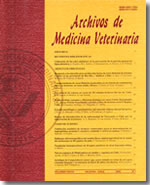Densidades de carga utilizadas para el transporte de bovinos destinados a matadero en Chile
Contenido principal del artículo
Resumen
Se determinaron las densidades de carga empleadas en el transporte de 413 cargas (camionadas) de bovinos, que comprendieron un total de 12.931 animales, recibidos en dos plantas faenadoras en Chile durante el año 2002, una en la X Región y la otra en la Región Metropolitana. Para las cargas recibidas en la planta de la X Región, las densidades de carga registradas fluctuaron entre 106 y 693 kg/m2 (promedio 457 ± 6,6 kg/m2) y en la Región Metropolitana fluctuaron entre 268 y 632 kg/m2 (promedio 453 ± 9,7 kg/m2). En ambas regiones se observó una tendencia a que las densidades de carga usadas en los vehículos de mayor tamaño (camiones simples y con carro) fueran mayores; la mayoría de las cargas animales eran transportadas en este tipo de vehículo. Las densidades de carga encontradas para los viajes más largos no difirieron de aquellas usadas para los viajes cortos en el caso de la Región Metropolitana; sin embargo, en el caso de las cargas recibidas en la X Región se observó que en general los animales transportados por distancias más largas viajaron a densidades de carga mayores. En general, 32,4% de las 413 cargas revisadas, que correspondieron a 35,6% de todos los bovinos, sobrepasaron el límite de densidad de carga permitido por la legislación vigente (500 kg/m2). Considerando que la literatura indica que el ganado bovino transportado a muy altas densidades, particularmente sobre 500 kg/m2, sufre mayor estrés y produce inferior calidad de carne, especialmente en términos de mayor incidencia de contusiones, y que, además, en Chile las canales con contusiones que afectan el tejido muscular sufren una degradación en cuanto a la categoría de tipificación, reduciendo su valor económico, se recomienda, tanto desde el punto de vista de bienestar animal como de calidad de carne, al menos respetar el límite máximo de densidad de carga establecido para el transporte de ganado bovino en Chile.

